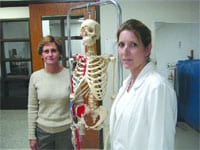Work in Progress The Role of the Occupational Therapist Assistant Continues to Evolve
Marianne Joyce says the word ‘occupational,’ as used in the term occupational therapy, might lead one to believe that those who enter this field focus on issues restricted to work.
But while it’s true that occupational therapist assistants do help people trying to return to their jobs after injury or illness, this profession is more about life than work, she told The Healthcare News — all aspects of life and all stages of it.
Indeed, a COTA, as such an individual is called (the ‘c’ stands for certified) might provide assistance ranging from work to help a child with cerebral palsy learn how to use a computer, to efforts to assist a stroke victim with relearning how to dress himself, said Joyce. And she should know. She’s been in this field for more than 30 years, and still practices early intervention (work with infants), in addition to her day job, department chair of the Occupational Therapy Assistant Program at Springfield Technical Community College.
“Occupational-therapy practitioners help clients across the life span reach functional goals related to play, work, education, and self-care,” she explained. “People associate us with helping someone get back to their work situation, but to us, that term ‘occupation’ is much broader. It involves all the things that you do throughout your day — getting up in the morning, showering, getting dressed, having breakfast … all throughout the day until you lie down again.”
Through her time in this field, Joyce said she’s seen the role of the COTA evolve over the years, and also witnessed a rise in demand for such individuals, primarily due to the graying of America. This phenomenon has resulted in a surge in both the quantity and quality of applicants for STCC’s program, the only one of its kind in the region, as well as heightened demand for graduates; most of all of the recent degree earners have jobs lined up long before commencement.
These jobs are in venues ranging from neonatal intensive care units to rehab facilities to long-term care centers, said Christy Wassung, a recent graduate of the STCC program and now an instructor there. And the long-range prognosis (job-wise) is for increasing demand for COTAs, she continued.
“There’s a good market for skilled therapists today — demand is high,” she explained. “And it doesn’t look like that situation is going to change any time soon.”
Degrees of Progress
Joyce told The Healthcare News that the profession of occupational therapist assistant emerged in the years just after World War II, when there was a clear need for individuals who could help wounded veterans with many aspects of everyday life.
In those days, assistants were essentially trained on the job, she explained, adding that by the mid ’70s, as the profession continued to evolve, college programs were created to formally train individuals and prepare them for the certification exam they are now required to take to enter the field.
STCC’s program, which Joyce helped spearhead, was established in 1994. It currently graduates about 12 students a year, a number limited by current facilities and staffing levels, but one Joyce would certainly like to see go higher given the current high demand for COTAs.
The STCC program involves a wide variety of courses and hands-on work both in an on-campus rehabilitation clinic frequented by individuals whose insurance doesn’t fully cover needs, and in off-campus sites such as area hospitals and outpatient rehab facilities. Both are intended to make graduates workforce-ready, Joyce explained.
Courses, designed to both provide a clinical background and develop skills in critical thinking and problem-solving, include, in year one, General Psychology, Anatomy and Physiology, Physical Pathology, and Movement and Function. In year 2, offerings include Occupational Therapy Media, Current Issues Across the Continium of Care, a seminar, and two eight-week practicums.
A two-year degree is needed to become a COTA, said Joyce, while a master’s is needed to progress to the role of occupational therapist, who essentially develops programs to be administered by the assistants. Some who have attended STCC, but not many, have made that professional leap.
The STCC program is currently drawing the attention of a diverse group of applicants and accepted students. Indeed, Joyce said the current classes include both recent high-school students and older individuals seeking second careers. The ages range from 18 to 55.
“It’s a really good mix,” said Joyce. “We even have some people with bachelor’s degrees.”
These students will be vying for jobs with both good starting salaries and opportunities for ladder climbing, she continued, adding that those who work on a per-diem basis, as many do, can easily earn $27, $28, or more per hour, while those who work full-time can start at $35,000, with some positions paying closer to $40,000, with the opportunity to go much higher.
Those who join the profession currently work in a variety of settings, and take on a number of responsibilities.
Her own assignments involve work with children, from birth to age 3 or so. Specific work will include such things as helping an infant transition from a feeding tube to the bottle, and it highlights the many aspects of the COTA’s job description.
“I’m focused on getting such children to be able to eat with their muscles, so this involves motor skills and muscle control,” she explained. “I’m looking at strength and coordination, but I’m also looking at their ability to sequence their breathing with their sucking, so I’m looking at respiration and control.
“Beyond that, I’m thinking that this is the time when a mother bonds with a child, which is so important for the psychosocial development of that baby,” she continued. “So I’m teaching the mother how to hold the baby in the best way to ensure that they’re not choking or gagging; it’s very hard for a child that been tube-feeding since birth to make that transition.”
But COTAs also work in schools, outpatient rehab clinics, long-term care facilities, and in clients’ homes, where they help patients, usually elderly individuals, with tasks, that, collectively, allow them to remain safe and independent.
Joyce said there is often confusion concerning the job descriptions for both the COTA and the physical therapist assistant, or PTA. Clarifying matters, she said that in the years after World War II, there was an informal, invisible line on the body, roughly in the middle, that would serve to divide the duties of these health care professionals.
“The OTs would do the upper half of the body, and the PTs would do the lower half,” she said, describing a division of labor that still exists today in some ways. “Occupational therapy and physical therapy have different points of focus. As an occupational therapist, we look at the mind and body, while the physical therapist is looking purely at the physical aspects.
“Take walking to the grocery store for example,” she said, citing a theoretical case involving a person recovering from stroke or injury. “The physical therapist would be focused on walking endurance, while the occupational therapist would be thinking about the cognitive aspects, planning out meals for the week, and determining what is needed.”
Hands-on Experiences
Looking forward, Joyce and Wassung said that employment opportunities in occupational therapy have historically been cyclical, with demand rising and falling, but the long-term outlook is for fewer peaks and valleys and, instead, consistently high demand.
That’s because this profession isn’t about getting people back to work. Instead, it’s about getting them on with their lives. As the population grows and ages, there will be much more to this assignment.
Which bodes well for those known as COTAs — and for those who want take on that acronym.


